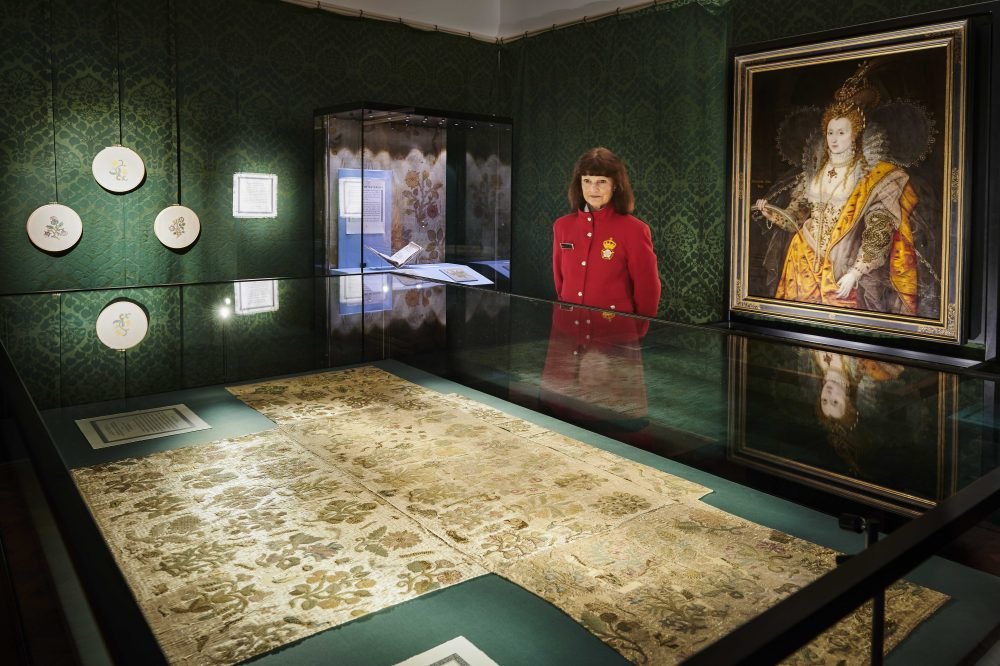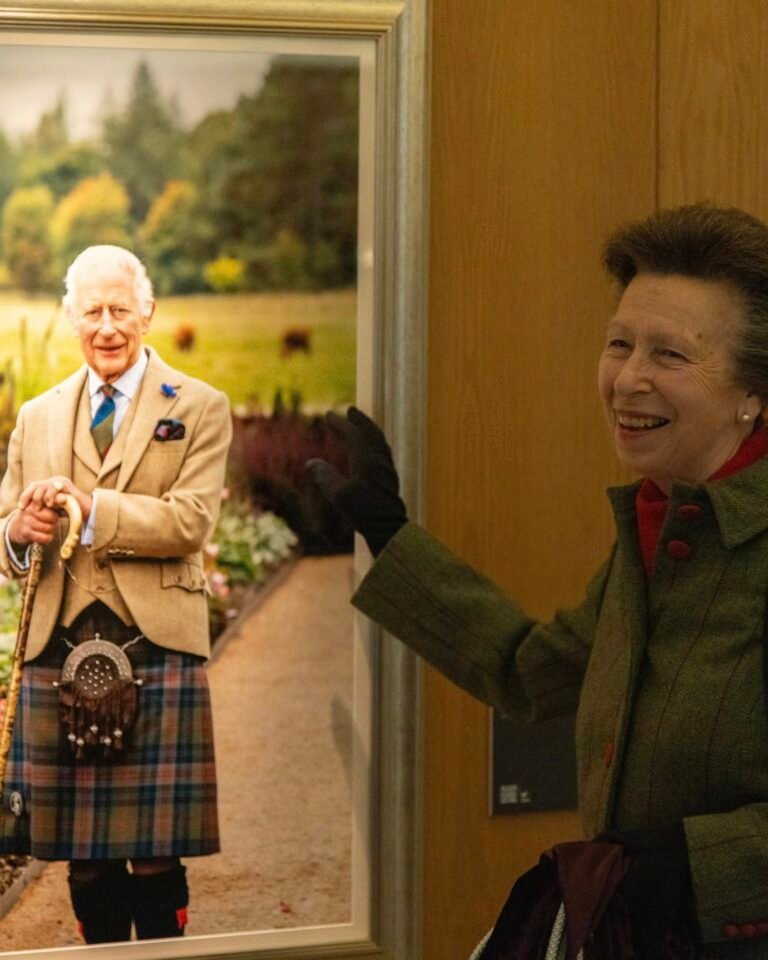An enormously rare piece of Tudor clothing, known as the Bacton Altar Cloth, is now on show at Hampton Court Palace – and it was once one of Elizabeth I’s dresses. The piece has long had local legend linking it to Gloriana, but now the experts are almost certain the Tudor Queen once wore it.

The richly-embroidered cloth of silver features large floral motifs – raspberries, mistletoe, peas, roses – interspersed with smaller animal icons – molluscs, bees, caterpillars, bears, frogs. It was created into an altar cloth for a rural church in Herefordshire, giving it this T shape.
A three-year project of research and conservation has brought the cloth back to the fore, telling us that this was indeed one of Elizabeth I’s dresses. It is now back within the walls where it might once have been worn by the Queen, sitting alongside the famous rainbow portrait of the Tudor monarch, on loan from Hatfield House, still the family seat of the Cecils.
The reason it is so important, is that so little historic dress from the period survives, particularly royal clothing. Due to the expensive nature of clothing, items and fabrics were repurposed until they could no longer function. In addition to this, the Great Fire of London (1666), and the later fire at the Palace of Whitehall (1698) all but wiped out the remaining royal dress collection.
Dr Eleri Lyn, one of the curators at HRP, was writing her book on Tudor fashion, when she came across an image of the cloth, and had to arrange a visit to see it in person. It was then that the Bacton Altar Cloth came to the fore.
“The altar cloth looked to be late 16th-century to me, so I thought I’d better go have a look,” Lynn says. “Really excitingly, we know that Blanche received gifts from Elizabeth herself, so I went there slightly heart-in-mouth.”
“As soon as I saw it I knew it was special, because of the materials and the level of skill in the embroidery,” she says.


How do we know it was Elizabeth’s dress?
1) Cloth of Silver
The dress was made of cloth of silver, which was strictly regulated by Tudor sumptuary laws. They dictated who could, and couldn’t, wear certain types of clothing and fabric, to help differentiate amongst the classes and keep people in their place (although the government line was that it helped protect people from bankruptcy through extravagance..!). Cloth of silver was reserved for ‘all degrees above viscounts, and viscounts, barons’ – so this would have been worn by a Countess or member of the Royal Family only.
As Elizabeth aged, she became increasingly paranoid and made sure her ladies dressed demurely, so that they could not take away any attention from her. She would publicly berate any lady who overstepped the mark in this regard, so we can be sure that it was only the Queen wearing dresses like this.

2) The date
Dating puts the cloth squarely in the 1590s, due to the style of the florals. Anything from the early Stuart period would have featured more scroll-liked detail from the stems and vines.
3) The quality and cost
This dress is wildly lavish with astonishing workmanship, and it was clearly for someone of substantial status. It was made for conspicuous consumption – a vanity project to focus attention on the wearer. Early inventories of Elizabeth’s do not show such dresses were in the wardrobe, but later ones do, telling us the Queen was purchasing high-quality items like this.
Dyes tested in the fabric show the red came from Mexico and the indigo from India, while the embroidery is incredibly fine, and was – unusually for such a luxurious and expensive piece – stitched straight onto the fabric by an expert workman. The usual process was to embroider the print onto a piece of linen, cut it out, then appliqué the decorative patch on.


The benefit of this was twofold: it enabled any mistakes to be rectified (either in terms of placement or the embroidery of the patch itself), and also enabled the base fabric to be reused (by simply cutting the stitches that attach the patch) since fabric was so expensive.
The stitching is so expertly finished, that the tension is evenly spread across the cloth, meaning the floral emblems have survived the best.
The fauna we see was added later, likely by Elizabeth’s ladies to give new life to her old dress. Fashion was minutely documented at court, with ambassadors reporting back to their masters who was wearing what, but Elizabeth was also frugal, and would ‘mix and match’ different aspects of dress to create a new look.

The ladies were less skilled than the master craftsman who originally made the piece, thus many of the later animal depictions are damaged, partly due to the tension not being spread as evenly.
Estimates put this dress at the same price as a substantial house in the period.
4) The link to Bacton
The altar cloth has been in Bacton for centuries. Local legend has always declared its royal links to Blanche Parry, the most senior lady-in-waiting at court, and Elizabeth I. Blanche was from Bacton, having been born and raised in the parish, and she had even hoped to be buried there, with an ornate monument to the lady and Queen being created in preparation, such was her love for her hometown.

As Blanche died in 1590, some 13 years before Elizabeth, Dr Eleri Lyn has a theory as to how the dress reached the church. In the three weeks after Elizabeth’s death, when it was still a closely guarded secret as James VI had not yet been informed of his succession, the dress was packaged up and sent to Bacton, probably by another lady-in-waiting as a final gift from the Queen.
Here, it was made into an altar cloth, with the remnants of the dress being repurposed elsewhere, perhaps for other liturgical items.
It is additionally known that Elizabeth often gifted Blanche her old clothing, as a sign of affection to her oldest friend. While Blanche died in 1590, and the Queen paid for her funeral at St Margaret’s, Westminster.
5) We have evidence of its existence…
The similarity it shows to the Rainbow Portrait, c.1600-1602, is remarkable. This was first noticed by a biographer of Blanche Parry, Ruth E. Richardson. The portrait was painted by Marcus Gheeraerts the Younger, and was commissioned by Robert Cecil, the spyamster and Secretary of State at the time; note the eyes and ears on the skirt.
Lynn notes that the floral pattern is quite similar to the original books from which these images might have been based, which were very popular at the time. And if we take into consideration the artistic license that was likely used, this brings together the portrait and the cloth even further.

Conservation included cleaning the cloth with dry facial sponges, and replacing the damaged and pest-ridden wool backing the church gave it, with a new silk backing; the aim was to stabilise the fabric and prevent any further damage. The light damage the cloth has received is irreversible, but one side of the piece, that was hanging in the shade away from the window, is of a noticeably-better quality.
The Bacton Altar Cloth was worn by Elizabeth I, and now, after four centuries it has returned to Hampton Court Palace, where Elizabeth I spent much of her time. It will be staying with HRP for the foreseeable future, but is still owned by St Faith’s, Bacton.
The exhibition:
Visitors will also see some samplars created by the Royal School of Needlework, which is housed at Hampton Court. They have analysed the stitching of the Bacton Altar Cloth and recreated a number of floral emblems in their original colours to highlight the beauty as it would have been seen in the late 1500s. The detail of the stitching is, as you would expect, exquisite, and visitors are encouraged to touch the samplars to get an idea of the textures.



Tudor lighting, Eleri explained, was obviously candles. But shelving often contained silver plate in high status houses and palaces, meaning the shimmer of the dress would have been gorgeous. The Queen would have further stood out as a woman amongst the many men at court, and in rich fabrics amongst a sea of officials wearing black.
A selection of rare domestic books dating from the Tudor period accompany these items. These books would have provided inspiration for many of the embroidered motifs fashionable during Elizabeth’s reign, and look to have been a source used by Marcus Gheeraerts the Younger as he painted the Queen.
You can see the Bacton Altar Cloth from 12th October until 23rd February 2020, when the piece will be stored an allowed to rest. Get tickets here.










Very nice video. Just a shame that at the beginning the voice over says that the church is in Herefirdshire, not Norfolk. Perhaps that can be corrected.
Hi Stuart; the video says Herefordshire and is correct. It is St Faith’s, Bacton, not the Bacton in Norfolk
V.